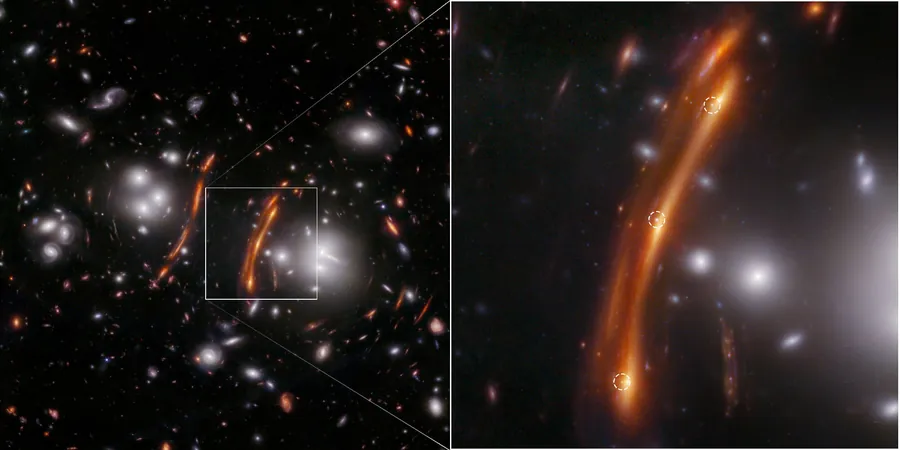
Groundbreaking Discovery: Researchers Confirm Gravitational Lensing Reveals True Hubble Constant!
2024-10-01
Groundbreaking Discovery: Researchers Confirm Gravitational Lensing Reveals True Hubble Constant!
Astronomers around the globe are engaged in a fierce race to unravel the mysteries of the universe's expansion, and NASA's James Webb Space Telescope is leading the charge. In a recent groundbreaking discovery, researchers have confirmed previously measured values of the Hubble constant, while also introducing an innovative technique that could redefine our understanding of cosmic expansion.
The Hubble constant is a crucial number that indicates the universe's expansion rate. While data from both ground- and space-based observatories has contributed significantly to measuring it, the Webb telescope is shining a new light on the issue. Earlier this year, astronomers utilized data from Webb, which includes Cepheid variables and Type Ia supernovae, to reaffirm findings from Hubble's observations.
Now, a team led by Brenda Frye from the University of Arizona has made waves by employing a fresh method: the observation of gravitationally lensed supernovae. This pivotal research began when they discovered three distinct points of light in the densely packed galaxy cluster known as PLCK G165.7+67.0, which had not been evident in earlier Hubble images from 2015.
Dr. Frye reflected on the team’s enthusiasm, stating, “The question that sparked our investigation was, 'What are those three dots that weren't there before? Could that be a supernova?'” Their initial analyses soon confirmed their suspicions: they had indeed identified a Type Ia supernova—specifically, one being gravitationally lensed.
Gravitational lensing is a fascinating phenomenon where a massive object, in this case a cluster of galaxies, distorts the light from objects behind it. This optical illusion creates multiple images of the same astronomical event, akin to looking into a tri-fold vanity mirror, each reflecting a different phase of an exploding star’s light. In this case, the supernova's light reached Webb at three distinct intervals, allowing astronomers to gather data on the explosion's timing and the universe's dynamics.
Dubbed “SN H0pe,” this supernova not only provides a visual spectacle but also holds the key to a more precise calculation of the Hubble constant, denoted as H0. The gravitational lensing effect enables astrophysicists to assess critical factors such as time delays, supernova distance, and the lens' characteristics—all of which coalesce to yield a value for H0.
In a bold move to further investigate SN H0pe, the PEARLS-Clusters team put forth a proposal for additional observations, which were subsequently authorized. Utilizing both Webb and ground-based telescopes in Arizona, they confirmed SN H0pe's significant connection to a background galaxy existing 3.5 billion years after the Big Bang, making it one of the most distant Type Ia supernovae documented to date.
Compiling data from seven separate lens models that portrayed the galaxy cluster's 2D matter layout allowed researchers to refine their results. Each model was objectively assessed for its ability to match the observed time delays and brightness of the supernova, ensuring a rigorous and unbiased analysis.
Their findings revealed the Hubble constant value to be approximately 75.4 kilometers per second per megaparsec, with a margin of error of plus 8.1 or minus 5.5. This measurement is pivotal not just for its precision but also because it integrates the standard candle method for Type Ia supernovae, a first of its kind in this context.
As Frye remarked, "This is one of the great Webb discoveries, paving the way to a deeper understanding of the fundamental parameters of our universe."
With the Webb telescope set for more observations in its third cycle, researchers anticipate even more significant insights, potentially resolving existing discrepancies in Hubble constant measurements and reshaping our understanding of the universe's structure since its inception. Get ready to witness the universe unfold in ways we've never imagined!



 Brasil (PT)
Brasil (PT)
 Canada (EN)
Canada (EN)
 Chile (ES)
Chile (ES)
 España (ES)
España (ES)
 France (FR)
France (FR)
 Hong Kong (EN)
Hong Kong (EN)
 Italia (IT)
Italia (IT)
 日本 (JA)
日本 (JA)
 Magyarország (HU)
Magyarország (HU)
 Norge (NO)
Norge (NO)
 Polska (PL)
Polska (PL)
 Schweiz (DE)
Schweiz (DE)
 Singapore (EN)
Singapore (EN)
 Sverige (SV)
Sverige (SV)
 Suomi (FI)
Suomi (FI)
 Türkiye (TR)
Türkiye (TR)